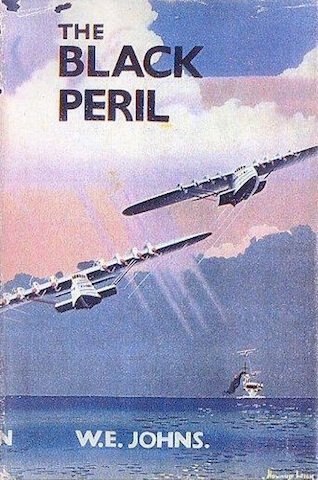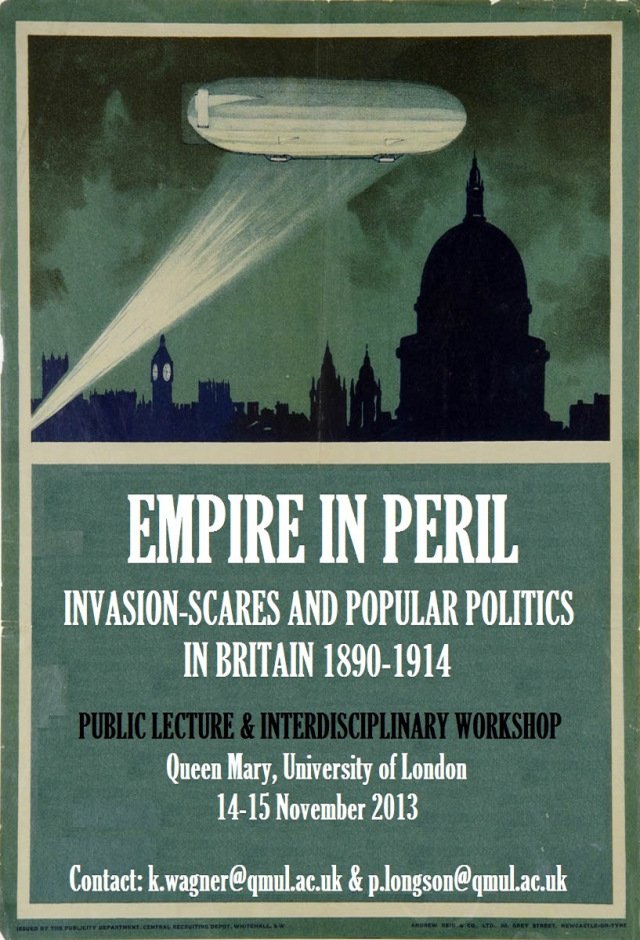A recent post on io9 mentioned Le Péril Bleu, a 1912 French novel by Maurice Renard (who also wrote the oft-filmed Les Mains d’Orlac, ‘The hands of Orlac’). According to io9, Le Péril Bleu features ‘invisible aliens who lived in the upper strata of the atmosphere[,] fish for humans and keep them in a space zoo’. This sounded to me suspiciously like a British science fiction story published in Pearson’s Magazine that same year, John N. Raphael’s ‘Up above’.1 I re-read Raphael’s story to refresh my memory: set in 1915, it concerns the mysterious disappearance of various objects and people, ranging from a pub’s sign to the Prime Minister. Other strange occurrences included houses being demolished and a fall of red rain. It turns out that the ‘Sky Folk’ are responsible; they live on the boundary between the upper atmosphere and outer space, and have been sending expeditions down to the Earth’s surface to trawl for specimens, in the same way that we might explore the bottom of the sea bed. This analogy is very explicit: the Sky Folk’s vessel labeled a ‘sub-aerine’, and the people and objects they pull up are put on display just like fish in the new Oceanographic Museum in Monaco. (The Sky Folk and their sub-aerine are invisible, apparently in the same way that we are invisible to fish. Or that we can’t see very well under water. No, I don’t get it either.)
So it does sound a lot like Le Péril Bleu. But before I could cry ‘J’accuse!’ I noticed the following disclaimer on the first page of Raphael’s version:
The central idea and some of the details of this story have been borrowed by permission from “Le Péril Bleu,” by Maurice Renaud [sic].2
With that, all my dreams of making a major historical discovery — the literary fraud of the Edwardian age! — vanished. I’ll have to win fame and fortune some other way.
But there’s still some interesting stuff in Raphael’s story. For a start, while it’s not about aerial warfare as such, it does recapitulate some familiar themes. Most generally, there is the idea of a threat from above. This is so even though humanity itself is itself starting to conquer the sky:
Since, in 1913, the airman, O’Farrell, revolutionised aeroplaning by his invention of the perfect stabilisator, aeroplanes of all kinds, and hydro-aeroplanes had been enabled to hover over a fixed point exactly as a seagull hovers.3
One of the unfortunate victims of the Sky Folk, Mr Verulam, became ill when he was picked up, different to ‘the ordinary air sickness which I remember feeling on my first trip to Paris in an aeroplane’, which suggests that international air travel is now somewhat common, at least for the well-off.4 There’s the symbolic demonstration of Britain’s aerial weakness, in a scene when a sub-aerine has an accident and crashes onto Trafalgar Square, knocking over Nelson’s Column. There’s the predictable reaction of the mob to danger:
Then, more quickly than I can tell you, further catastrophe followed. I heard the roar and crash of falling masonry. I heard the screams and shrieks of women, the shouts of men, the hoarse cries of police ordering people to stand back, the yells and confusion of a panic-stricken crowd fighting in semi-darkness to escape from a danger which they only half understood, and trampling one another down to certain death in their efforts to avoid the uncertain death which they feared.5
And of course there’s also the need for Britain to arm in the air. Having worked out pretty much what’s going on, the Professor — there’s always one in these kind of stories — writes a letter to The Times declaring that it was ‘the absolute duty of England to equip an air expedition immediately’, for the purposes of vengeance against the Sky Folk.6
But there’s another possible connection to one of my interests, namely phantom airships. In an article published in Magonia in 1991, the sceptical ufologist Martin Kottmeyer looked for possible connections between the American mystery airship waves of 1896 and 1897 and later UFO sightings:
It is actually easier to trace the development of the UFO mythos to the British airship scare of 1912-13. These flaps were clearly paranoid in character, involving as the did the belief that German Zeppelin airships were secretly visiting Britain for spying out the land in preparation for war. There seems to be no compelling reason to doubt it inspired John N. Raphael to pen “Up above: The story of the sky folk” for the British Pearson’s Magazine.
He goes on to suggest (following science fiction historian Sam Moskowitz) that the American anomalist Charles Fort likely read Raphael’s story and that it influenced his later suggestion (belief is usually too strong a word for Fort) that extraterrestrials are watching and sometimes interacting with us, and not always to our benefit. When the modern UFO era began in 1947, early ufologists picked up on Fort’s — and hence Raphael’s — idea, and there went the neighbourhood.
I won’t deal here with Kottmeyer’s argument about Fort being influenced by Raphael, and ufologists being influenced by Fort. But what about the suggestion that Raphael was ‘inspired’ by the phantom airship wave of 1912-3?
The first problem with this is that, as I’ve already noted, Raphael quite openly acknowledged his literary debt to Renard’s Le Péril Bleu. Given this, and the close similarity in outline between the two stories, there’s no need to search for a real-world inspiration. However, I gather that Renard’s version of the story was less paranoid than Raphael’s. While noting the similarity with Fort’s later idea that ‘we are property’, according to Wikipedia Le Péril Bleu ‘retains a humanistic and tolerant rather than fearful and xenophobic philosophy’. ‘Up above’ is certainly fearful and xenophobic: the fall of red rain noted above is actually blood, which the Sky Folk dump overboard after vivisecting their human specimens. Mr Verulam’s body was similarly dumped overboard, partially skinned. In true Lovecraftian fashion he had kept a diary of the terrifying things he had seen and heard:
The boy next to me has gone. I saw what was done to him before he disappeared. It is too awful. I dare not even attempt to describe it. I lay in the farthest corner of my cell shivering and screaming aloud as those awful invisible knives worked and worked on that naked body. I suppose it will be my own turn before long.7
So perhaps this hints at a darker relationship between the British and the air above than the French had, and the fearful realisation that England was no longer an island worked its way into Raphael’s retelling of Renard as a morbid spin. But again, this is not necessary. The French had their own fears, and anyway The War of the Worlds is a perfectly adequate British precedent for how a technologically-superior ‘them’ might treat an unjustifiably-complacent ‘us’ (though arguably vivisection is a step down even from genocide: the Sky Folk don’t recognise humans as being intelligent at all. At least Wells’s Martians had to fight us.)
Moving from the general to the specific, there’s a problem with timing. ‘Up above’ was published in the December 1912 issue of Pearson’s Magazine, which means it was out by the first of the month (the issue is reviewed in The Times, 2 December 1912, 10). But the phantom airship scare of 1912-3 really did not get going until January 1913; while there were some sightings in October, November and December, with one exception they received little or no press attention. Even if Raphael banged his story out in short order, it would still take some time to go to press. What’s more, ‘Up above’ is accompanied by five full pages of (I think) colour illustrations and twelve small line drawings which were clearly specially commissioned and can’t have been produced in too much of a hurry. So figuring a month (at least) for all of that and Raphael can’t have begun work later than the start of November, say.
Which makes it just possible that the Sheerness incident was an inspiration for Raphael. This took place on 14 October, but again was not widely reported until about a month later, when questions were asked in Parliament. However The Aeroplane reported 31 October on rumours that something — a Zeppelin or perhaps a naval aviator — had been flying over Sheerness at night. It’s interesting that the Sheerness thing was heard but not seen; this is true also of the invisible sub-aerine in ‘Up above’, which is notable for the strange sounds it makes, like countless slate pencils grating and squeaking over countless greasy slates’.8 Maybe Raphael knew of this rumour and incorporated it into his story, but that’s about all the influence I am able to allow for the phantom airship-Raphael connection.
NB. There’s very little about ‘Up above’ on the web, aside from an Australian review of the subsequent novel. But I must go back in time and take this course.
![]() This work is licensed under a Creative Commons Attribution-NonCommercial-NoDerivatives 4.0 International License.
Permissions beyond the scope of this license may be available at http://airminded.org/copyright/.
This work is licensed under a Creative Commons Attribution-NonCommercial-NoDerivatives 4.0 International License.
Permissions beyond the scope of this license may be available at http://airminded.org/copyright/.
- John N. Raphael, ‘Up above’, Pearson’s Magazine 34 (December 1912), 710-60. [↩]
- Ibid., 710. [↩]
- Ibid., 754. [↩]
- Ibid., 738. I was going to say that this must be an early use of the phrase ‘air sickness’; in fact the OED has three earlier cites, the first being Horace Walpole in 1784! [↩]
- Ibid., 753-4. [↩]
- Ibid., 733. [↩]
- Ibid., 750. [↩]
- Ibid., 720. [↩]





Interesting article regarding the Sheerness incident.
http://www.sheernessheritagecentre.com/page29zeppelnraid1tww.htm
Well, it’s interesting insofar as they’ve cut-and-pasted my own post on the Sheerness incident without attribution …
Though its subject matter is somewhat tangential to “Le Péril Bleu”, one is also reminded of the nearly contemporaneous work published by Sir Arthur Conan Doyle in 1913. His tale, entitled “The Horror of the Heights”, involves stratospheric predators which prey upon the first aviators to venture into their realm.
… first mention of Lufthansa’s fight attendants?
Very much so, Paul! The text of ‘The horror of the heights’ can be found here, and this is one of the original Strand illustrations for it.